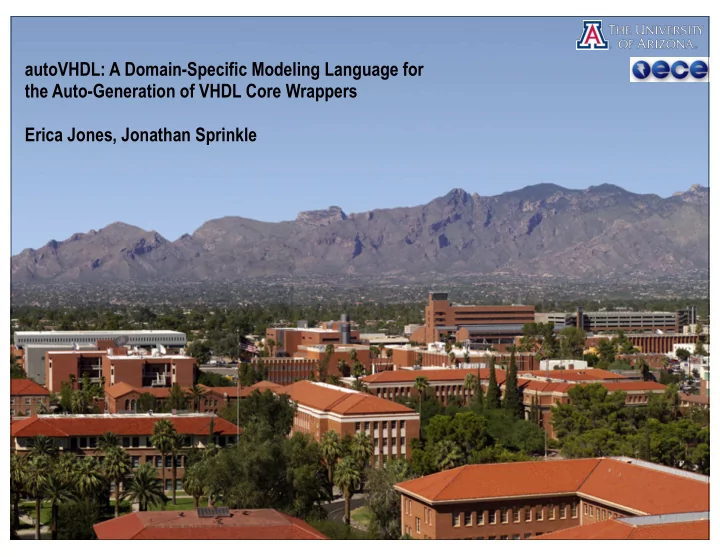

autoVHDL: A Domain-Specific Modeling Language for the Auto-Generation of VHDL Core Wrappers Erica Jones, Jonathan Sprinkle
Domain motivation for “correct by construction” embedded systems Electrical and Computer Engineering 2
Before they fly....a PRE-prototype is tested -- HARDWARE IN THE LOOP! Electrical and Computer Engineering NOTE: Images are representative of hardware in the loop test cases, but are images gathered from various contextual searches, not representing systems discussed in this paper. 3
But the problem doesn’t have to be missiles---all HWIL domains apply: Electrical and Computer Engineering • Just pretend like we are using this technology to make computing safe for kittens. 4
State of the art, and context Electrical and Computer Engineering • HWIL prototypes must realistically capture the information flow architecture of the designed system – Bus width/frequency must be matched – Proper voltages, interfacing – Communications engines must comply with standards • “Core” technology is deployed into reconfigurable hardware – Speedy execution – Realistic power draw – Componentized behaviors, available for reconfigurable hardware execution • e.g., 8b10b, UART, SDLC • “Core” technology difficult to rapidly reuse, due to suble differences in the interface specification, depending on the domain-specific application of the cores • Much of the difficulty lies in rapidly rehosting a core on different hardware, with different communication specification pathways, due to the distributed specification of the communication pathways in hardware 5
Why hasn’t it been done already? Electrical and Computer Engineering • Significant effort in developing VHDL • How to improve on VHDL? – Many folks tried to create “simply” more clever graphical versions – However, all of these approaches resulted in clumsier languages, that were unable to solve the entire design space---so they were “failures” • This approach limits the intended application space • The domain-specific approach permits us to focus on a particular application where we can have impact – Thus, the fact that there are some things that “raw” VHDL does better than us is still OK---we are not trying to do that – Likewise, those folks who are actually working in this domain can utilize this tool to more rapidly stand up hardware pre-prototypes for testing 6
Contribution of this work Electrical and Computer Engineering • A domain-specific modeling approach to generate the high-level description language for hardware deployment, based on an application model • The language relies on centralized specification of the domain concepts, and uses a graphical syntax • The generated files are able to be synthesized on board standard hardware, and executed in order to validate design criteria 7
Context: VHDL Electrical and Computer Engineering • VHDL: VHSIC Hardware Description Language • Hmmmmmm: – VHSIC: Very-High-Speed Integrated Circuits • An architecture description, to tell a chip how to arrange itself -- sqrt8m.vhdl unsigned integer sqrt 8-bits computing unsigned integer 4-bits -- sqrt(00000100) = 0010 sqrt(4)=2 -- sqrt(01000000) = 1000 sqrt(64)=8 -- modification of sqrt8.vhdl with specialized circuits library IEEE; use IEEE.std_logic_1164.all; entity Sm is -- subtractor multiplexor port ( x : in std_logic; y : in std_logic; b : in std_logic; u : in std_logic; d : out std_logic; bo : out std_logic); end Sm; architecture circuits of Sm is signal t011, t111, t010, t001, t100, td : std_logic; begin -- circuits of Sm t011 <= (not x) and y and b; t111 <= x and y and b; t010 <= (not x) and y and (not b); t001 <= (not x) and (not y) and b; t100 <= x and (not y) and (not b); bo <= t011 or t111 or t010 or t001; td <= t100 or t001 or t010 or t111; d <= td when u='1' else x; end architecture circuits; -- of Sm library IEEE; use IEEE.std_logic_1164.all; entity Sb is port ( x : in std_logic; y : in std_logic; b : in std_logic; bo : out std_logic); end Sb; .... 8 ....
This paper: NOT a tutorial on VHDL...let’s look at the domain: Electrical and Computer Engineering Top Module clock start Data[7..0] dout 8 8b10b Data Register addressBus 10 8 kerr Xilinx CoreGen Bus Module rd/Wr’ 8b10b Encoder disp_out kin[0] dataBus Control Register 16 ce[1] ack clk8b10b 9
Recommend
More recommend